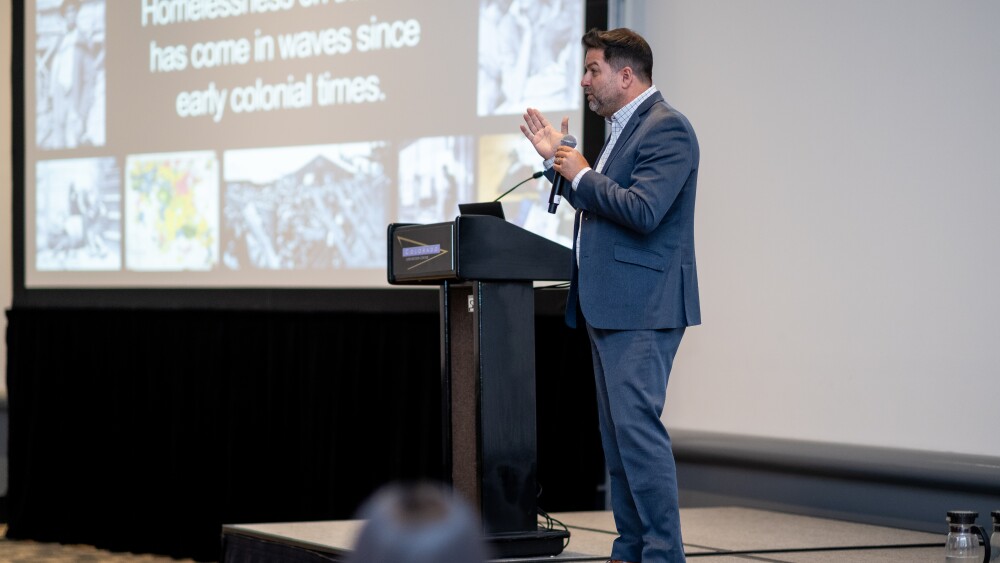At the recent Homeless to Housed Symposium—part of the ULI 2025 Spring Meeting in Denver, Colorado—Jeff Olivet, a prominent expert in advancing solutions to homelessness, delivered a keynote address. In it, he not only contextualized the current state of homelessness in the United States but also provided a foundational framework for the forthcoming 10 Principles for Addressing Homelessness: A Guide for Commercial Real Estate & Finance. His insights could catalyze productive discussions and spur action among stakeholders in the public and private sectors.
Olivet has dedicated more than three decades to addressing this complex and pressing issue. His career is marked by significant roles, including his past stint as the executive director of the U.S. Interagency Council on Homelessness, where he spearheaded initiatives aimed at reducing homelessness nationwide. Olivet’s journey began in the early 1990s, as a volunteer working with displaced people in East Africa. That experience eventually led him to work in homeless shelters in the United States, directly with people affected. This rich background has shaped his understanding of the manifold factors contributing to homelessness, and of the vital importance of community engagement and collaboration in finding effective solutions. Urban Land sat down with Olivet in Denver to learn more about his work and the current state of the housing crisis.
UL: What are the current trends in homelessness across the U.S.?
Jeff Olivet: We’re in a place of real crisis, and we’re seeing communities struggling with the volume of people who are becoming homeless for the first time. We still see terrible housing market pressures in terms of cost of housing, availability of affordable rental housing. There’s simply not enough to go around . . . . When they do become homeless, it becomes very hard to exit homelessness. We’ve seen the numbers spike in the last couple of years, and a lot of that’s driven by economic factors—the cost of housing simply outpaces the wages that people have to pay for it. We also saw a lot of the pandemic-era resources show incredible success in stabilizing people—the emergency rental assistance dollars, emergency housing vouchers, expansion of the Child Tax Credit, other strategies that were extremely effective—but then they were not continued permanently because there wasn’t bipartisan support in Congress for the long term . . . . The reality that we’re seeing is between housing market factors and the end of a lot of those one-time resources. We’re seeing the numbers increase pretty dramatically.
UL: What are the underlying factors contributing to inequality in homelessness, and how do societal perceptions shape our understanding and discussions about this issue? Is the impact primarily in the way we talk about it, or are there deeper issues at play?
Olivet: It’s both. Homelessness is always tied up with racial disparities. People of color are dramatically more likely to be homeless in the United States than their white peers. It’s especially true for African American people and Native American people, and you can trace those roots historically to how Native people were pushed off their lands. You can trace it to federal policies, like redlining in the 1930s, that still have ripple effects today around the racial wealth gap, and who has been able to develop generational wealth through home ownership. And if we’re not willing to have courageous conversations about the racial disparities that exist, we will never solve this problem effectively. We have to be able to say it is true that people of color experience homelessness at higher rates; now, what are we going to do about it from a policy point of view? How are we going to right those wrongs?
UL: What are some examples of things that you see that could right those wrongs?
Olivet: We’ve seen communities, all over the country, first analyze the numbers to understand the demographics of who’s homeless. And that’s not just about race. That’s also about age. It’s about gender, it’s about household type. It’s about whether somebody is a veteran, or a disabled person, or an elderly person. If we assume all people experiencing homelessness are one thing, then we’re never going to get the complex solutions in place that we need . . . . I see geographic targeting of resources to areas that are deeply impoverished, that don’t have the resources . . . other communities do, so that can be looking at homelessness prevention by zip code, for example, which is an incredibly effective approach that is not racialized. It’s not affirmative action in any kind of way . . . . I do think the inquiries regarding diversity, equity, and inclusion are potentially very harmful to communities of color, and I think they’re confusing to the providers who are supporting housing and case management, mental health access, and drug and alcohol treatment, because they see the reality that many of the people they serve are in households of color, and yet they’re being told by the federal government not to talk about it.
UL: What are some of the most encouraging innovations you’re seeing?
Olivet: We see incredible work happening around specific sub-populations. We see very good work happening around youth homelessness, around helping young people either prevent homelessness from happening once they’ve aged out of foster care or, if they are homeless, making sure they have very good support and the opportunities necessary to find housing, get engaged in school and work and family and community. We continue to see great success on veteran homelessness, which is the big success story. Over more than a dozen years of bipartisan support, we’ve seen veteran homelessness in this country decreased by 55 percent—that’s an incredible success. We ought to be looking at that and saying, Okay, how did we do the housing and health care and wraparound supports that made that happen? And how can we replicate that for other populations?
I’m also seeing some compelling work around proactive homelessness prevention, and some of it was based on models that were pioneered before and during the pandemic, where we were able to stabilize households insecure housing to make sure they didn’t slip over the edge. And there’s an increasing body of evidence to show how to do that, and I think that’s one of the most promising things going on right now.
UL: What has made programs that support unhoused veterans so successful?
Olivet: Some are started by veterans and veteran-run peer organizations, and those are a wonderful part of the picture. But there’s also been a significant federal investment in housing and wraparound supports for homeless veterans, and most of that has been done . . . through programs such as HUD–VASH, the U.S. Department of Housing and Urban Development–Veterans Affairs Supportive Housing, or another program called Supportive Services for Veteran Families, SSVF. Those two programs have helped hundreds of thousands of veterans and their families get off the street in the last decade. Strategies for success are not a mystery.
UL: In what ways can public health and public health initiatives contribute to reducing homelessness?
Olivet: Another bright spot we’re seeing is more investment by health and hospital systems stepping into the space of funding and providing affordable housing, on the development side of things, to increase housing supply. Better kinds of cross-systems collaboration, where hospitals are working more closely with homeless providers, behavioral health providers, and bringing a public health sensibility to this work, but also bringing resources to the table. And I do think there’s a shift happening, where many people are increasingly seeing homelessness as both a housing problem and a public health crisis, and addressing them together. If we could take on that mindset as a nation, I think we could really make terrific headway.
UL: Can you talk about collaboration between government agencies and nonprofit organizations in tackling homelessness?
Olivet: I’ll expand your question a bit and say collaboration is essential between the public sector—government at all levels; federal, state, and local nonprofit service providers; housing providers; health care providers—and the corporate sector, the business community, and the faith community, where it’s everybody rowing in the same direction.
UL: What does your future hold, and what do you hope to see? How do you hope to see the conversation shifting in the near future?
Olivet: Right now, the next couple of years, I’m focused on local impact, because I think there’s some great stuff happening in cities and counties all over the country. I’m focused at the intersection of health and homelessness. I’m doing some work as a senior advisor to the Initiative on Health and Homelessness at the Harvard T.H. Chan School of Public Health. I’m also doing work around youth homelessness with a group called Chapin Hall and based in Chicago. And I’m focused a lot around homelessness prevention, trying to turn off the faucet, because in the 32 years I’ve been in this work, we’ve been bailing the bathtub, and I think if we don’t stem inflow, we’re going to be bailing that bathtub for a long time.
What I hope happens over the next couple of years is that the resources that are being invested stay strong, that those are protected, that they continue. I would hope that the corporate sector steps up more, and the philanthropic sector steps up more, and I would hope that we all start shifting our focus upstream to stop homelessness before it starts.
UL: In your opinion, what is the potential impact of ULI’s Homeless to Housed initiative?
Olivet: I am excited about ULI’s work in this area because it holds the potential of strengthening partnerships between the real estate world, the housing development world, and the homelessness response. Historically, these groups haven’t always worked together as closely as they could. ULI’s Homeless to Housed initiative brings important partners to the table with a deep understanding that we all have a role to play in solving the crisis of homelessness in America.
UL: How can ULI leverage its unique position to drive meaningful change in addressing homelessness?
Olivet: ULI reaches a large and important audience—real estate and land use experts, developers, and people involved in housing finance—people doing great work in communities across the country. The skills and networks of ULI members could be transformative for how communities tackle homelessness.
UL: What is the role of ULI members—leaders in private sector real estate and commercial finance—in addressing homelessness?
Olivet: Everyone has a role to play. Affordable housing developers can partner with service providers who have expertise in wraparound supports. Real estate professionals can serve on boards of local nonprofits and Continuum of Care programs. ULI members can build bridges and create a broader community understanding that housing—with good wraparound supports—is the fundamental solution to homelessness.
You can learn more about ULI’s Homeless to Housed Initiative here.








